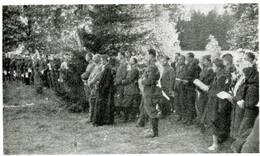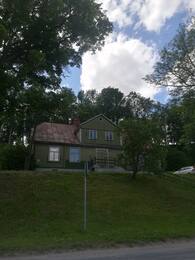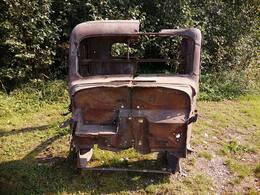Kurelininkai: už Latviją prieš svetimas okupacines jėgas
Antrojo pasaulinio karo bunkeriai Malnavoje ir Hitlerio apsilankymas vo kiečių armijos grupės „Šiaurė“ štabe
Hitlerio apsilankymas vokiečių armijos grupės „Šiaurė“ štabe Malnavoje ir netoliese esantis priešlėktuvinės gynybos bunkeris dažnai minimi kaip susiję objektai. Tačiau juos sieja tik bendra vieta – Malnavos dvaras; jokio tiesioginio ryšio tarp šių įvykių nėra.
1941 m. liepos 12–28 d. Malnavos dvare buvo įsikūręs vokiečių armijos grupės „Šiaurė“ štabas vadovavęs puolimui Leningrado kryptimi. Vieta buvo pasirinkta dėl praktinių priežasčių – buvusiame dvare veikusi Malnavos žemės ūkio mokykla turėjo modernią infrastruktūrą: elektros apšvietimą, centralizuotą vandentiekį, dušus ir kanalizaciją. Štabas buvo įrengtas viename iš dvaro šoninių korpusų, o likusioje pastato dalyje mokykla veikė toliau.
Hitleris štabą aplankė 1941 m. liepos 21 d. Jis kartu su lydinčiais asmenimis atskrido dviem „Junkers“ lėktuvais, lydimais devynių „Messerschmitt“ naikintuvų. Apsilankymas truko vos kelias valandas, bet buvo įamžintas vokiečių fronto kino kronikose ir išliko Malnavos mokinių prisiminimuose.
Maždaug už 70 metrų nuo dvaro stovi priešlėktuvinės gynybos bunkeris, įrengtas 1944 m. pradžioje, kai karo eigoje sovietų aviacija ėmė dominuoti oro erdvėje, o vokiečių karinės pajėgos pradėjo trauktis. Grupės „Šiaurė“ štabas Malnavoje buvo nuo vasario iki liepos vidurio.
Atminimo akmuo kureliečių atminimui Skrīverių valsčiuje
Atminimo akmuo kureliams prie „Robežių“ namų Skrīverių valsčiuje, atidengtas 2015 m.
„Pasienio“ namai Skriverių valsčiuje
Skrīverių valsčiaus „Pasienio“ namas yra vieta, kur 1944 m. liepos 28 d. prasidėjo generolo J. Kurelio grupės formavimasis.
Strazdės dvaras
Strazdės dvaras yra Rygos–Ventspilio plento pakraštyje ir nuo 1944 m. rugsėjo 29 d. iki spalio 28 d. buvo generolo Janio Kurelio grupės štabas. Dvaro pastatuose buvo dislokuotas Skrīverių batalionas, vadovaujamas pulkininko leitenanto Eduardo Graudinšo. Kureliai buvo 1944 m. vasarą Vidžemėje iš Rygos apygardos gvardijos suformuotas karinis dalinys, kurio tikslas buvo atkurti Latvijos nepriklausomybę tarp Vokietijos armijos atsitraukimo ir SSRS kariuomenės puolimo Latvijos teritorijoje.
Nuo 1922 m. mokyklos reikmėms smarkiai perstatytas, rekonstrukcijos metu prarado savo pirminę išvaizdą ir proporcijas. Strazdės dvarą supa gražus parkas.
Jekelno būstinė Talsuose
Šiame Talsų pastate 1944 m. lapkričio 3 d. generolas J. Kurelis ir kapitonas K. Upelnieks vedė derybas su SS obergrupefiureriu F. Jekelnu ir kitais vokiečių karininkais. Istorinis pastatas buvo nugriautas, o jo vietoje statomas naujas.
Buvusi parduotuvė / policijos pastatas
Buvęs parduotuvės / policijos pastatas Talsuose, Kr.Valdemāra 2, kuriame nuo 1944 m. lapkričio 14 iki 19 d. buvo kalinami generolo J. Kurelio grupės štabo pareigūnai.
Kureliečių būstinė Stiklose
Stikli miestelyje esantis Anahitų medžioklės namelis buvo kureliečių būstinė Antrojo pasaulinio karo metu nuo 1944 m. spalio 29 d. iki lapkričio 14 d. Šis pastatas išliko iki šių dienų.
Stikli apylinkėse gausu ne tik pelkių ir miškų, bet ir smėlio. 1897 m. pradėjo veikti naujoji anahitų stiklo gamykla – taip ši Latvijos gyvenvietė gavo pavadinimą Stikli. 1900 m. ten pat, ant Stikli ežero kranto, buvo pastatyta vadinamoji anahitų medžioklės pilis, tiksliau sakant, pastatas, kuriame gyveno gamyklos vadovas.
Kureliečių atminimo akmuo Stiklose
Atminimo akmuo kureliečiams prie anahitų medžioklės namelio „Stiklos“ Puzės valsčiuje, atrastas 1997 m., perkeltas 2023 m.
Šalia akmens yra informacinė lentelė su QR kodu, kurioje audiogidas pasakoja istoriją apie kurelius.
Atminimo vieta senosiose Anahitų kapinėse
Atminimo vieta senosiose Anahitų kapinėse, kur palaidoti 1944 m. lapkričio 14 d. per vokiečių apgultį generolo J. Kurelio grupės štabo ir pagrindinių pajėgų žuvę kareiviai ir civiliai.
Atminimo paminklai generolo J. Kurelio grupei ir leitenantui R. Rubeniui „Dzelžkalnų“ kapinėse
Atminimo akmenys generolo J. Kurelio ir leitenanto R. Rubenio grupei Puzės parapijos „Dzelzkalnių“ kapinėse. Atidengti 1997 m.
Atminimo ženklai buvo įrengti dar prieš įkuriant Rubenio bataliono muziejų.
Rubenio bataliono muziejus
Rubenio bataliono muziejus yra Ugalėje. Jis skirtas R. Rubenio batalionui, kuris 1944 m. tarnavo ir kovojo Kuržemėje vadovaujant generolui J. Kureliui, kurelių veiklai ir nacionaliniam pasipriešinimo judėjimui. Muziejuje yra ekspozicija apie Latvijos Centrinės Tarybos (LKT) ir jos Ventspilio grupės veiklą, taip pat LKT memorandumas su 188 parašais ir signatarų nuotraukomis, įtrauktas į UNESCO programos „Pasaulio atmintis“ Latvijos nacionalinį registrą. LKT buvo bendras Latvijos aukščiausios politinės vadovybės ir pogrindinės vyriausybės, veikusios Latvijos okupacijos metu nuo 1943 iki 1994 m., centras. Jis buvo įkurtas siekiant koordinuoti įvairių Latvijos pasipriešinimo judėjimų veiklą, siekiant atkurti Latvijos nacionalinę nepriklausomybę. Muziejus taip pat siūlo kelionę į bataliono istorijai reikšmingas vietas (gyvenvietę su rekonstruotu bunkeriu Usmos valsčiuje, mūšio laukus Rendos ir Zlėkų valsčiuose ir kt.).
Rubenio bataliono bunkeris ir mūšio laukai
Restauruotas Rubenio bataliono 2-osios kuopos žeminė yra miške prie Ilziki ežero Usmos valsčiuje. Žeminę galima apžiūrėti iš išorės nemokamai bet kuriuo metu. Tačiau ekskursijas žeminės viduje būtina užsisakyti iš anksto.
Leitenanto Roberto Rubenio batalionas buvo generolo Jānio Kurelio suformuoto karinio dalinio dalis ir žinomas dėl to, kad nepasidavė vokiečių kariuomenei ir demonstravo didelį pasipriešinimą. 1944 m. lapkričio 14–gruodžio 9 d. Ugalės, Usmos, Rendos ir Zlėkų valsčiuose vyko įnirtingi mūšiai tarp 16-osios Vokietijos armijos, SD ir SS dalinių, vadovaujamų policijos generolo Friedricho Jeckelio, ir Kureliečių dalinio bataliono, vadovaujamo leitenanto Roberto Rubenio. Rubenio vadovaujami vyrai buvo gerai ginkluoti ir organizuoti, nesiejo savęs su jokia iš dviejų priešiškų okupacinių jėgų. Jų veiksmai laikomi plačiausiais ir ilgiausiais Latvijos nacionalinio pasipriešinimo judėjimo istorijoje. Mūšiuose prie Rendos ir Zlėkų žuvo apie 250 vokiečių kareivių, o Rubenio vyrai patyrė tik 50 aukų. Tų dienų įvykius simbolizuoja miške atkurta žeminė (velėna dengta, žemėje iškasta rąstinė trobelė), kurioje kadaise buvo apsistoję Rubenio bataliono vyrai.
Paminklas Rubenio bataliono medikams
Paminklas Cirkalės kapinėse kunigams Ārijai Stiebriņai ir Veltai Vaskai, kuriuos vokiečiai sušaudė 1944 m. lapkričio 9 d. Sukūrė skulptorius J. Karlovas.
Abi moteris 1944 m. gruodžio 9 d. sušaudė Vokietijos nacių armijos daliniai kartu su kitais nelaisvėje paimtais Zlėkų apylinkių gyventojais, dezertyrais iš Vokietijos armijos ar panašiais asmenimis.
Pasak pasakojimų, jaunos moterys savanoriškai įstojo į Rubenio batalioną. Jos keliavo kartu su Rubenio batalionu iš Suntaži į Usmą. Tačiau Jekelno operacijos „Eichensumpf“ metu jaunos moterys buvo suimtos kelyje, nuvežtos į Vēlogų girininko namus tardymui ir sušaudytos kartu su nedidele grupe kitų sulaikytųjų. Cirkalės gyventoja moteris pažinojo Āriją ir sugebėjo perlaidoti abiejų mergaičių palaikus Cirkalės kapinių pakraštyje bei prižiūrėjo šias kapines per visą sovietų okupaciją.
Vadovaujant vyriausiajam SS ir policijos vadui Ostlande, SS obergruppenfiureriui ir policijos generolui Friedrichui Jecklenui, gruodžio 5–9 dienomis vyko didelio masto operacija „Eichensumpf“ („Ąžuolų pelkė“), nukreipta prieš „Raudonosios strėlės“ kovotojus ir generolo Kurelio grupę netoli Abavos.
Kampanijos eiga iš dalies dokumentuota 1944 m. gruodžio 31 d. ataskaitoje.
Avarijos vieta netoli Čiubu namų Rendos valsčiuje
„Čiūbų“ namai yra į šiaurę nuo Ozolų, Rendos valsčiuje. Susidūrimas su vokiečiais prie leitenanto L. Znutėno antrosios kuopos, priklausančios leitenantui V. Strautnieko batalionui, Čiūbų namų įvyko 1944 m. lapkričio 16 d.
Paminklas sušaudytiems leitenanto R. Rubenio bataliono kariams
Rubenio bataliono karių kapinės yra Kuldygos–Sabilės kelyje, priešais vietą, kur anksčiau buvo Rendos daktaro disertacija. Prie kelio yra rodyklė, o vos už kelių šimtų metrų nuo kelio – paminklinis akmuo.
Leitenanto Roberto Rubenio batalionas buvo viena iš generolo Jānio Kurelio suformuoto karinio dalinio dalių, kuris nepasidavė vokiečių kariuomenei ir demonstravo aršų vokiečių pasipriešinimą. Usmos laikotarpiu bataliono skaitinė sudėtis išaugo iki 650 vyrų, jame buvo keturios pilnai įrengtos kuopos, greitoji medicinos pagalba ir ūkio komanda. Vadovaujantis štabas: leitenantas R. Rubenis, leitenantas Filipsons, eilinis A. Druviņš, eilinis Šulcs, eilinis Briedis, eilinis seržantas J. Rubenis, eilinis J. Bergs, eilinis Jaunzems.
1944 m. lapkričio 14–gruodžio 9 d. Ugalės, Usmos, Rendos ir Zlėkų valsčiuose vyko įnirtingi mūšiai tarp policijos generolo Friedricho Jekelno vadovaujamų Vokietijos 16-osios armijos, SD ir SS dalinių dalių ir leitenanto Roberto Rubenio vadovaujamo Kurelių dalinio atskiro bataliono. Mūšiuose prie Rendos ir Zlėkų žuvo apie 250 vokiečių kareivių, o Rubenio pulkas patyrė apie 50 aukų.
Po leitenanto Rubenio mirties Druvinšas savo vyrams paskelbė, kad nuo šiol veiks savanoriškai, todėl kelios dešimtys vyrų nusprendė atsiskirti nuo Rubenio bataliono. 1944 m. lapkričio 20–21 d. vokiečių SD dalinys sugavo 11 žmonių grupę ir po tardymo nuvežė į vietinį mišką bei sušaudė.
Rubenio bataliono mūšių vieta 1944 m. gruodžio 6–9 d.
Atminimo vieta leitenanto R. Rubenio bataliono mūšių vietoje 1944 m. gruodžio 6–9 d., tarp „Vėverio“ ir „Dzilno“ namų Ugalės valsčiuje.
Rubenio bataliono mūšių vieta 1944 m. lapkričio 18 d.
Atminimo vieta leitenanto R. Rubenio bataliono mūšių vietoje 1944 m. lapkričio 18 d., tarp „Pērkono“ ir „Mežzīlių“ namų Rendos valsčiuje.
Baltasis kryžius ir egzekucijos vieta Karostoje
Baltasis kryžius ir egzekucijos vieta priešais Liepojos Karostos kalėjimą. Atidengtas 2000 m.
Generolo Kurelio štabo karininkų sušaudymo vieta
1944 m. liepos pabaigoje, Raudonajai armijai įsiveržus į Latvijos teritoriją, vokiečių okupacinė valdžia leido Rygos rajono policijos viršininkui ir atkurtos Latvijos gvardijos organizacijos 5-ojo Rygos gvardijos pulko vadui Jāniui Veidei įkurti „Rygos gvardijos pulko Generolo Kurelio grupę“. Jos vadu tapo Latvijos Centrinės Tarybos Karinės komisijos vadovas Latvijos armijos generolas Jānis Kurelis.
Kureliai Vidžemėje veikė iki 1944 m. rugsėjo mėn., kai persikėlė į Kuržemę, kur buvo dislokuoti Stiklių namuose Puzės valsčiuje, Ilzikių Usmos valsčiuje, Ilinių Gibuli valsčiuje ir Edolėje bei kitose Šiaurės Kuržemės vietose. Iki 1944 m. spalio pabaigos kureliečiai turėjo apie 3000 ginkluotų vyrų, tarp kurių buvo daug buvusių Latvijos SS savanorių legiono dalinių karių, kurie įstojo į dalinį, kad įgyvendintų savo svajonę – kovą už Latvijos nepriklausomybę.
1944 m. lapkričio pradžioje vokiečių okupacinės valdžios vyriausioji policija ir SS vadas Ostlande, SS oberrupenfiureris Friedrichas Jeckelnas, pradėjo riboti grupės veiklą ir lapkričio 14 d. Stikliuose, Pusios valsčiuje, suėmė kureliečių štabą ir daugiau nei 700 kareivių. Leitenanto Roberto Rubenso vadovaujamas batalionas, turėdamas apie 500 vyrų Usmos apylinkėse, priešinosi ir tęsė kovas iki 1944 m. gruodžio mėn.
1944-19-20 naktį vokiečiai kovojo prieš vokiečius. 1944 m. lapkričio 19-19 d. Liepojos Karaosto kalėjime vyko vokiečių okupacinės valdžios karo lauko teismas, kuriame buvo nuteisti mirti aštuoni generolo Kurelio grupės štabo karininkai - pulkininkas Pēteris Liepiņš, kapitonas Kristaps Upelnieks, kapitonas Jūlijs Mucenieks, leitenantas Jānis Gregoras, leitenantas Jānis Gregoras. leitenantas Filipsonas ir adjutantas Kārlis Valtersas. Trys štabo karininkai – pulkininkas leitenantas Eduards Graudins, leitenantas Arthurs Ankravs ir seržantas Vili Pavulāns dėl įvairių priežasčių buvo atleisti. Lapkričio 20-osios popietę nuteistieji buvo sušaudyti kopose prie Karostos kalėjimo, kur šiandien galima pamatyti baltą kryžių.
1994 m. Liepojos Karostos kopose buvo įkurtas memorialas sušaudytiems karininkams. 2012 m., po to, kai memorialas buvo nuplautas į jūrą, jis buvo atkurtas dabartinėje vietoje.
*** Išversta naudojant www.DeepL.com/Translator (nemokama versija) ***























